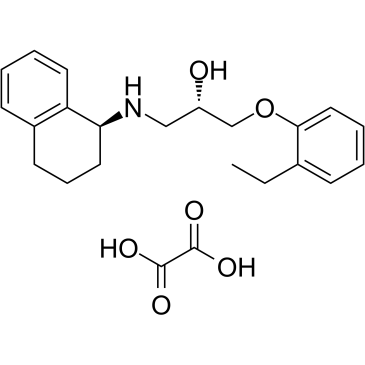| DC73377 |
AS408
|
AS408 is a negative allosteric modulator of the β2-adrenergic receptor (β2AR) for both G-protein activation and arrestin recruitment (pKB=6.8, [35S]GTPγS binding assays), binds to a pocket formed by the membrane-facing surface of TM3 and TM5. |
| DC72880 |
Norepinephrine hydrochloride
|
Norepinephrine (Levarterenol; L-Noradrenaline) hydrochloride is a potent agonist of adrenergic receptor (AR). Norepinephrine activates α1, α2, β1 receptors. |
| DC72329 |
Upidosin
|
Upidosin (Rec 15/2739) is an α-1 adrenoceptor (α-1 AR) antagonist. Upidosin shows moderate selectivity for the α-1A AR subtype. Upidosin shows uroselectivity in urethra and prostate with a Kb value of 2-3 nM higher than in ear artery and aorta with a Kb value of 20-100 nM. Upidosin inhibits [3H]prazosin binding to cloned human α-1A adrenergic receptor. Upidosin can be used for the research of urethral obstruction. |
| DC49622 |
A-61603
|
A-61603 is a selective α1A-adrenergic receptor agonist. A-61603 increases the frequency of spontaneous Ca2+ transients in rat ventricular myocytes in vitro. |
| DC29046 |
Ritodrine hydrochloride
|
Ritodrine hydrochloride (DU21220 hydrochloride) is a β-2 adrenergic receptor agonist. |
| DC28370 |
Dabuzalgron
|
Dabuzalgron (Ro 115-1240) is an orally active and selective α-1A adrenergic receptor agonist for the treatment of urinary incontinence. Dabuzalgron protects against Doxorubicin-induced cardiotoxicity by preserving mitochondrial function. |
| DC28149 |
SR59230A hydrochloride
|
SR59230A hydrochloride is a potent, selective, and blood-brain barrier penetrating β3-adrenergic receptor antagonist with IC50s of 40, 408, and 648 nM for β3, β1, and β2 receptors, respectively. |
| DC28121 |
CGP 20712 A
|
CGP 20712 A (CGP 20712 mesylate) is a highly selective β1-adrenoceptor antagonist with an IC50 of 0.7 nM. CGP 20712 A exhibits ~10,000-fold selectivity over β2-adrenoceptors. |
| DC28102 |
SR59230A
|
SR59230A is a potent, selective, and blood-brain barrier penetrating β3-adrenergic receptor antagonist with IC50s of 40, 408, and 648 nM for β3, β1, and β2 receptors, respectively. |
| DC28084 |
Hydroxybupropion
|
Hydroxybupropion is the major active metabolite of Bupropion. Hydroxybupropion is metabolized by CYP2B6.Bupropion is an atypical antidepressant and smoking-cessation agent. Hydroxybupropion inhibits norepinephrine uptake with an IC50 value of 1.7 μM. Hydroxybupropion is also a nACh receptor antagonis tis more potent than Bupropion . |






















